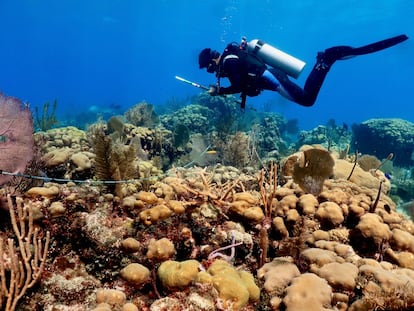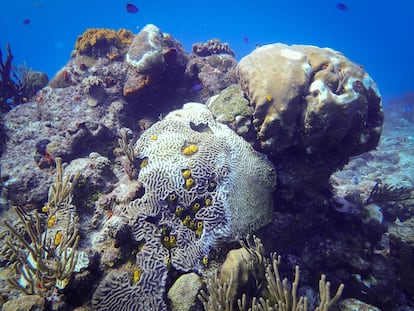A new disease is killing Mexico’s coral reefs
A new study shows that more than 20 species have been affected by the disease and some are at risk of extinction

Experts have identified a new disease that is killing coral reefs along Mexico’s Caribbean coast. First identified in Florida in 2018[JT1] , the outbreak reached Mexican waters at least four years ago. Since then it has ravaged the reefs along Mexico’s Yucatán Peninsula in the Caribbean Sea. A study published on June 9 in Nature, says the disease has affected at least 21 coral species, some of which are classified as structural species that help sustain reef ecosystems. At least 17% of the 29,000 coral colonies analyzed has died from the disease. The authors of the study say the disease will probably become the “most lethal ever identified in the Caribbean.”
It was originally described as the white plague and is now called stony coral tissue loss disease (SCTLD). Little is known about this blight that is decimating the Mesoamerican Barrier Reef System, the world’s second largest barrier reef. Lorenzo Alvarez-Filip, the author of the study and a researcher at the Institute of Marine Sciences and Limnology at the National Autonomous University of Mexico (Universidad Nacional Autónoma de México - UNAM), said that it was first thought to be a bacterial infection, which is why it was initially treated with antibiotics. “We mixed antibiotics into a putty-like material and spread it on the coral lesions,” said Alvarez-Filip. But recent research has revealed that it might be a virus, he said.
Alvarez-Filip and his team analyzed about 100 areas of coral reef between July 2018 and January 2020, and observed the deadly disease’s rapid progression along 200 miles of reef. In just a few months, they began to see corals covered with white spots, a sign that they had been dead for a short time. The Nature article reports, “Of the 29,095 colonies studied, 17% were already dead with signs of recent mortality.” According to the study, the mortality rate of some species reached 94%, while others had a low 10% mortality rate. The most heavily affected species were the Meandrinas family of corals, known as labyrinth corals, and the Faviidae brain corals. In the areas studied, almost 80% of these species died.
Researchers have not yet discovered how the disease spreads. Some theories point to boat traffic or tourism, but there is no definitive proof. But once the disease penetrates a reef, transmission is notoriously quick. “It’s extremely contagious–the same as the coronavirus. We now know that COVID is mainly transmitted through the air. SCTLD somehow spreads through the water–the environment in which the corals exist–and becomes extremely transmissible,” said Alvarez-Filip. SCLTD hasn’t yet been detected in the Chinchorro Banks, the most remote barrier reef off the coast of the Yucatán Peninsula.

SCLTD has had an enormous impact on an ecosystem already under stress. The study reports that half of the coral species in the Caribbean are being affected by this disease, and some face a high risk of extinction. Experts have learned that diseased corals produce 30% less calcium carbonate, the element that helps them build coralline structures.
Eric Jordan, a UNAM scientist specializing in coral communities, says, “SCTLD has shocked us with its aggressiveness, severity and rapid lethality.” Unfortunately, says Jordan, “It’s only the latest event in the history of coral biota degradation caused by lethal diseases.” For at least 40 years, coral reefs have been under attack by lethal diseases that spread through colonies faster than the coral can grow. Jordan blames deteriorating environmental quality caused by the effects of climate change, as well as regional and local changes. “Simply put, environmental conditions in the world’s seas are becoming less and less suitable for corals,” said Jordan.
Alvarez-Filip noted the drastic impacts that reef deterioration could have on society, especially coastal communities. “The reefs form a natural barrier that protects coastlines from wave energy, storms, and hurricanes. This [disease] will eventually destroy the barrier that protects us.” The loss of living coral reefs could also have an impact on the region’s fisheries, since reefs provide shelter for many fish.
The white plague has not spread to every Caribbean island or coast, but experts are not very optimistic. “We predict that if SCLTD spreads to all those places, they will experience very similar coral mortality rates to the areas we studied and also observed in Belize and Florida,” said Alvarez-Filip. What needs to be done now, he says, is preserve the species as much as possible until scientists thoroughly understand this new disease.
Tu suscripción se está usando en otro dispositivo
¿Quieres añadir otro usuario a tu suscripción?
Si continúas leyendo en este dispositivo, no se podrá leer en el otro.
FlechaTu suscripción se está usando en otro dispositivo y solo puedes acceder a EL PAÍS desde un dispositivo a la vez.
Si quieres compartir tu cuenta, cambia tu suscripción a la modalidad Premium, así podrás añadir otro usuario. Cada uno accederá con su propia cuenta de email, lo que os permitirá personalizar vuestra experiencia en EL PAÍS.
¿Tienes una suscripción de empresa? Accede aquí para contratar más cuentas.
En el caso de no saber quién está usando tu cuenta, te recomendamos cambiar tu contraseña aquí.
Si decides continuar compartiendo tu cuenta, este mensaje se mostrará en tu dispositivo y en el de la otra persona que está usando tu cuenta de forma indefinida, afectando a tu experiencia de lectura. Puedes consultar aquí los términos y condiciones de la suscripción digital.
More information
Últimas noticias
Most viewed
- Alain Aspect, Nobel laureate in physics: ‘Einstein was so smart that he would have had to recognize quantum entanglement’
- The US bombing of Venezuela, in pictures
- Maps of the US attack on Venezuela: Targets, airspace and deployed fleet
- Oil, gold and rare earth elements: the backdrop to US political tension with Venezuela
- Delta Force, the elite US military unit that captured Maduro










































